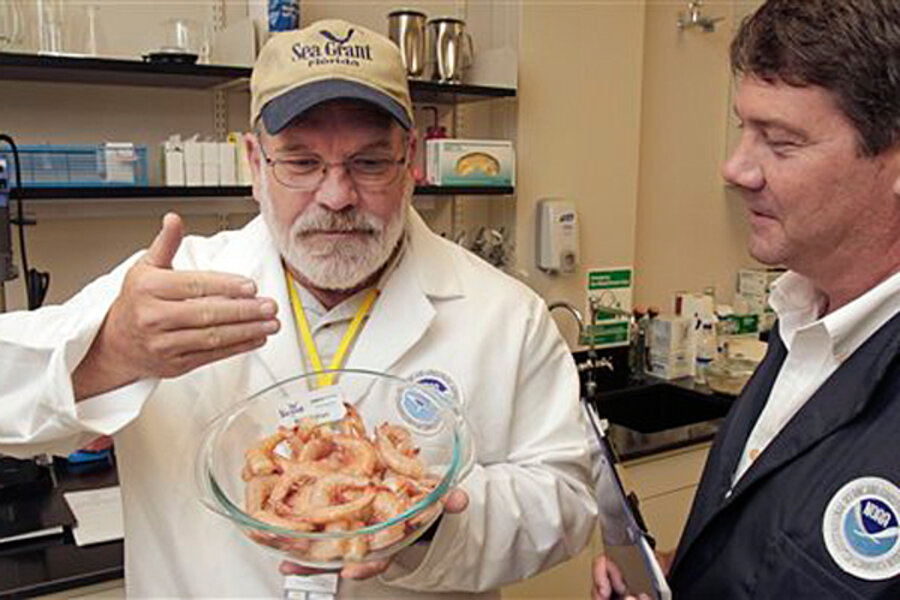Gulf seafood safety inspections ramp up as oil spill spreads
Loading...
Seafood inspection off the Gulf of Mexico is intensifying this week as the federal government allocates more resources to preventing harvests contaminated by the BP oil spill from reaching US dinner plates and restaurants.
The National Oceanic and Atmospheric Administration (NOAA) and the Food and Drug Administration (FDA) are together orchestrating a more thorough system of checks and balances that includes water and seafood sampling, dockside inspection, and a renewed rigor in reviewing when federal waters can be reopened.
The efforts reflect the aggressive, multiagency approach President Obama is expected to emphasize in his Oval Office speech Tuesday evening. Monica Allen, a spokeswoman with NOAA, said “the level of collaboration is definitely ramped up” between the two agencies in the Gulf effort – a situation she described as “extraordinary.”
'First line of defense'
The “strongest and the first line of defense” against preventing tainted seafood from making it to shore is the closure of federal waters, says Ms. Allen. To date, 32 percent of federal waters in the Gulf are closed to fishing.
To determine what areas should be opened and closed, federal officials use aerial monitoring and water sampling to track the oil’s movement. Those efforts will now be in tandem with a dockside inspection program of random screenings of fish caught outside the prohibited areas.
Before the April 20 Deepwater Horizon blowout, NOAA only conducted seafood screenings at Gulf ports for a fee and at the request of wholesale buyers to ensure the safety of their product.
The renewed dockside screenings will include workers trained as “sniffers” who will be able to evaluate if the catch is contaminated by its odor. “It’s the most sensitive forms of testing … if it fails that taint test, it’s out,” Allen says.
Starting last week and continuing though this week, more than 50 workers from agencies and organizations as varied as the Louisiana State University Department of Food Science to the Department of Wildlife and Fisheries, are undergoing training at the National Seafood Inspection Laboratory in Pascagoula, Miss.
There, they will be instructed how to use the smell test to detect hydrocarbons in seafood – a technique that can be used not only at dockside, but also for inspections in restaurants and processing facilities.
The sniffing technique is common and was used following the 1989 Exxon Valdez oil spill, says Joan Bowman, a spokesperson with the International Food Protection Training Institute, a nonprofit in Battle Creek, Mich., that is partnering with NOAA and the FDA.
It allows inspectors to evaluate “a large amount of product very quickly and very cost efficiently as opposed to sending a lot of seafood to a lab for testing, which is time consuming and expensive,” she says.
Samples collected at dockside will also be sent to the Northwest Fisheries Science Center, a NOAA facility in Seattle, for chemical evaluation.
More agents in the Gulf
The FDA is sending 50 agents into the Gulf region to help at all points of the screening process, said Meghan Scott, a spokesperson for the agency. They are expected to work alongside NOAA inspectors at dockside to monitor oysters, crab, and shrimp.
The FDA is also deploying a mobile laboratory to Tallahassee, Fla., where it will conduct chemical testing of sea life. Regional FDA laboratories in Arkansas, California, Florida, Arizona, and Wisconsin will also be running samples by the end of June.
The results of the exhaustive sampling and screening process by both agencies will be used to redraft the protocol determining what factors are needed to reopen closed waters.
On Tuesday the US Coast Guard seized about 19,000 pounds of shrimp from a boat illegally operating inside closed waters off the Louisiana coast.
Related:





